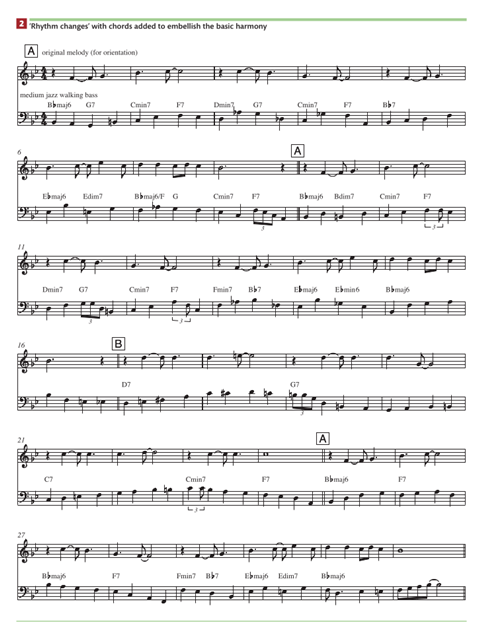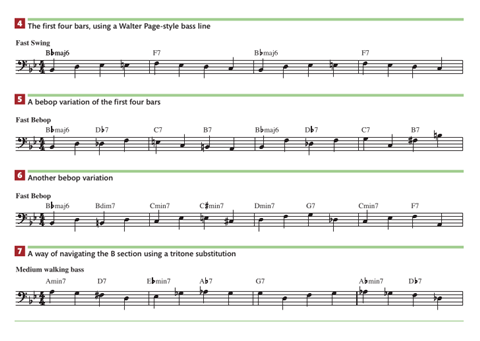Practical steps towards improvising like the greats on one of jazz’s most frequently performed progressions.
Taken from the April 2011 issue

‘Let’s Play Rhythm!’ That’s a phrase that jazz musicians often hear at jam sessions or on the bandstand. It means, ‘Let’s improvise on the harmonic structure of the great American classic song, I Got Rhythm.’ Jazz musicians have used the form and harmony of ‘rhythm changes’ (the jazz term for the harmonic structure of I Got Rhythm) for years as the basis for new jazz melodies and improvisations. The most durable and frequently played jazz forms are the twelve-bar blues and ‘rhythm changes’.
In this article, we’ll use walking bass lines to explore some of the many harmonic variations of ‘rhythm changes’.
HISTORY
I Got Rhythm was written by George and Ira Gershwin in 1930 and found its way into the show Girl Crazy. Following Ethel Merman’s performances in the original Broadway production, jazz musicians of the day soon picked up on the melody and harmony of the song as a vehicle for improvisation. In 1938, clarinettist Benny Goodman recorded one of the most famous versions of I Got Rhythm, with Gene Krupa, Teddy Wilson, and Lionel Hampton, released on Sony as Carnegie Hall Jazz Concert.
The most famous recording of the song as a bass feature comes from a concert at Town Hall in New York in 1945. Leroy ‘Slam’ Stewart and tenor saxophonist Don Byas play an incredible duet on the tune. Slam slaps his way in a driving two-beat bass line under Byas’s solo and then delivers his own incredible solo, complete with his trademark singing, in unison, one-octave above the bowed bass.
The most durable and frequently played jazz forms are the twelve-bar blues and ‘rhythm changes’
The performance is hard to find on CD, but is currently available through most digital music stores. During the swing and bebop eras, many jazzers used the harmonic structure of Gershwin’s classic as a basis for new melodies. When jazz musicians refer to ‘rhythm changes’, they are referring to the harmony, or chord progression and form of the original song. A jazz melody that is based on the harmony to a different song in this way is called a contrafact.
Songs like Duke Ellington’s Cotton Tail, Lester Young’s Lester Leaps In and Nat King Cole’s Straighten Up and Fly Right are all classic swing songs based on ‘rhythm changes’. Anthropology, Moose the Mooche and Steeplechase are a few of the famous ‘rhythm changes’ contrafacts composed by alto saxophonist Charlie Parker in the bebop era. Other notable ‘rhythm changes’ contrafacts include Sonny Rollins’ Oleo, Thelonious Monk’s Rhythm-A-Ning, and the cartoon theme Meet the Flintstones by Hoyt Curtin.
Playing over the harmony to ‘rhythm changes’ has become one of the ultimate tests of jazz mastery. It has provided a common canvas for the last 80 years of the jazz story, with everyone from Duke Ellington to Pat Metheny painting a piece of the picture.
THE NUTS AND BOLTS
What makes ‘rhythm changes’ such a solid basis for improvisation? What makes it so much fun to play? The chord progression is simple enough that a musician can successfully improvise over the structure using the pentatonic scale B flat, C, D, F, G. The more adventurous improviser can add substitutions and turnarounds, techniques we will explore here, to make the harmony ever more complicated.
The original form is AABA, four eight-bar phrases. A two-bar tag is added in the original composition, with a repetition of the line ‘Who could ask for anything more,’ making the original form 34 bars long. Almost all jazz contrafacts leave off the tag, making ‘rhythm changes’ a basic, 32-bar form. In its simplest variation, the first eight bars of ‘rhythm changes’ can be played as in example 1.

Jazz players usually choose to add chords to embellish the basic harmony. There are countless variations of ‘rhythm changes’, with many subtle differences. Example 2 shows the whole form with some typical variations. In bars 1 and 2, the simple option from example 1 is expanded to a turnaround.
Like the word suggests, a turnaround brings a chord progression round a cycle and back to a starting point. The basic I to V7 progression in example 1 (B#maj6 to F7) is expanded to I, VI7, II7, V7 (B#maj6, G7, Cmin7, F7). In bar 3, the turnaround begins on III7 (Dmin7), which is similar to the B#maj6 in sound. In bars 3 and 4, the turnaround leads into the B#7 chord in bar 5. There are many options for turnarounds in the first four measures of ‘rhythm changes’, and jazz players often change the chord progression spontaneously when improvising.
VARIETY IS THE SPICE
How do you know when to use variations of ‘rhythm changes’? This spontaneous, on-the-spot re-harmonisation is not as mysterious as it might seem. Jazz musicians improvise according to basic structures, but often add extra chords, or generalise groups of chords into one sound. When a player knows several harmonic variations of ‘rhythm changes’, then it’s second nature sometimes to change or embellish the chord progression instinctively in the heat of improvisation. An important aspect that helps jazz musicians pick and choose variations spontaneously is a common repertoire of historically important jazz songs.
For example, Miles Davis’s The Theme and Sonny Stitt’s The Eternal Triangle are both based on ‘rhythm changes’, but the chord progression in the B sections of both songs is different. Since experienced jazz players will have heard both songs quite a bit (they are classics), it’s easy to follow a soloist when they switch from one variation to another in the course of an improvisation. It sounds good when all players on the bandstand always play the same harmonic variations, but it is not always imperative.
Sometimes a soloist (or pianist or bassist) will add a variation that the other players do not hear, or do not choose to pick up on. What happens when one player improvises on a different set of chords from the other players? If players are improvising together and outlining different variations of the same underlying structure, the sound will still be cohesive. For example, if, as in example 3, the pianist plays B#maj6, Gmin7, Cmin7, F7 in the first two bars, while the bassist plays B#maj6, F7, the result is still harmonious.

They will both most likely land on either a Dmin7 or a B#maj6 chord on beat one of bar 3, so the turnaround – even though they are playing two different chord sequences – will still be complete and sound convincing. Another appealing aspect of ‘rhythm changes’ is the blues feeling that occurs in bars 5 and 6. The movement from the I7 chord (B#7) in bar 5, to the IV chord (E#maj6 or E#7) in bar 6, has a feeling similar to a blues progression. Bar 6 presents a tricky option, however: the chord on beats 3 and 4 can either be an Edim7, or an E#min6. This is an important spot for the bass player!
Note that in example 2, bar 6, the Edim7 is used, and in bar 14, the alternate choice presents itself: E#min6. Most jazz melodies favour one chord progression or the other, and most jazz players will stick to one variation of this measure throughout an improvisation.
The original Gershwin I Got Rhythm melody is best harmonised using E#6 to E#min6 in Bar 6. The B section (the third eight-bar phrase, also called the bridge) of ‘rhythm changes’ starts on the III7 chord (D7), and moves through the cycle of fifths (D7, G7, C7, F7) finally to resolve to B#maj6 to bring in the last A section. There are many popular variations of the chord progression in the bridge. A common addition is to put a minor chord before each dominant chord: Amin7, D7, Dmin7, G7, Gmin7, C7, Cmin7, F7. Beboppers love this variation because of the musically gymnastic aspect.
The last A section of example 2 (beginning in bar 25) shows a generalised chord progression, without the extra, beboppish harmonic variations found in the first two A sections. This line will work even if the other players are using different changes.
EVEN MORE CHANGES
Now let’s look at a few popular ways to navigate ‘rhythm changes’. Example 4 shows the first four bars of the A section, using a bass line similar to that performed by Walter Page in Count Basie’s 1938 hit Jumpin’ at the Woodside. Example 5 is a bebop variation of the first four bars, which uses dominant chords in chromatic motion.
Example 6 shows another common bebop variation. Note that the Bdim7 in bar 1 leads to the Cmin7 in bar 2. The C&min7 in bar 2 leads to the Dmin7 in bar 3.

Example 7 shows one of the many ways to navigate the B section (bridge)of ‘rhythm changes’. Instead of two bars of D7, we fi nd an Amin7 to D7 in bar 1, followed by an E#min7 to A#7 in bar 2. The E#min7 and A#7 are an interval of a tritone away from the Amin7 and D7, and lead nicely to the G7 chord in bar 3.
This type of progression is called a tritone substitution, a common bebop harmonic device. When chords are moving in a circle of 5ths, say, D7 to G7, we can substitute the D7 for the chord at the interval of a tritone, giving A#7 to G7. The tritone substitution adds tension and leads into the next chord in the cycle. If we add a minor chord in front of the dominant (Amin7 to D7), then we can also substitute the minor chord and dominant chord found a tritone away (E#min7 to A#7).
How do you go about becoming familiar with ‘rhythm changes’ in all its variations? Listen to jazz, and especially the various recordings of ‘rhythm changes’ mentioned in this article. Once you have the sound of the progression in your ear, your fingers will lead you to the best notes.
Technique: Jazz soloing on the double bass
- 1
- 2
- 3
- 4
- 5
- 6
- 7
 Currently reading
Currently readingFrom the archive: Interpreting ‘I Got Rhythm’
- 8
- 9
- 10
- 11
- 12
- 13























































No comments yet